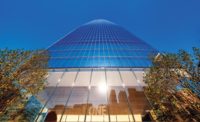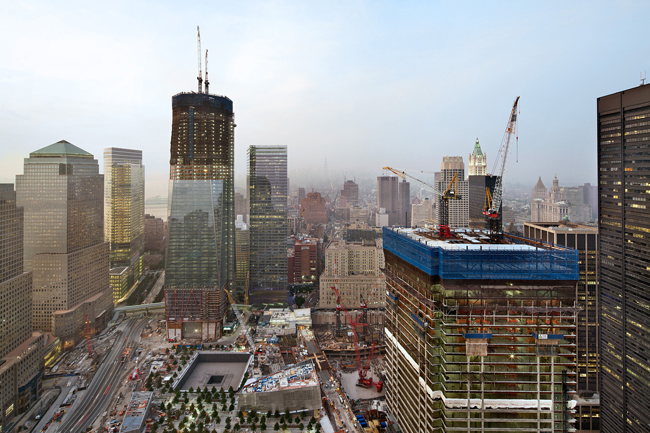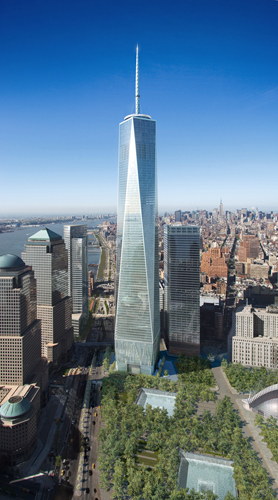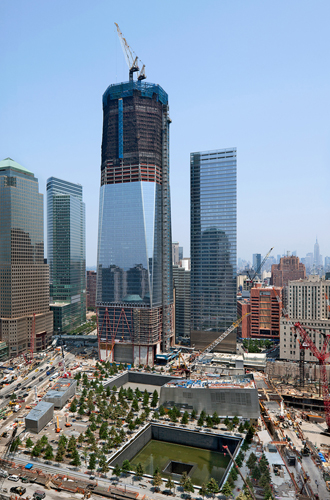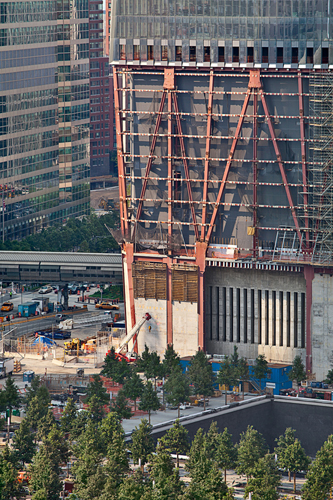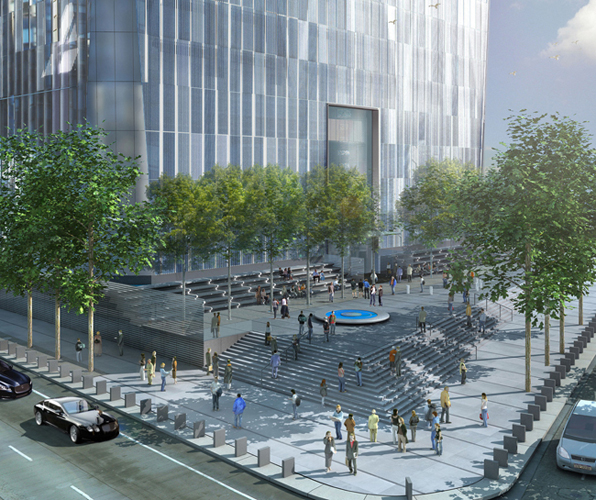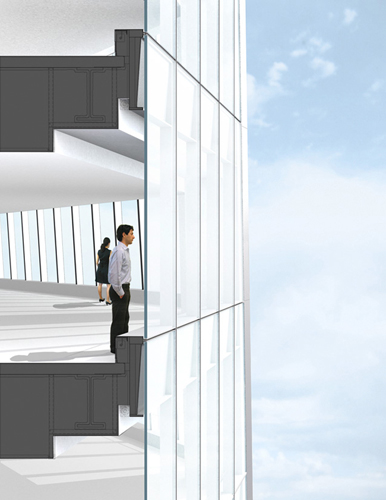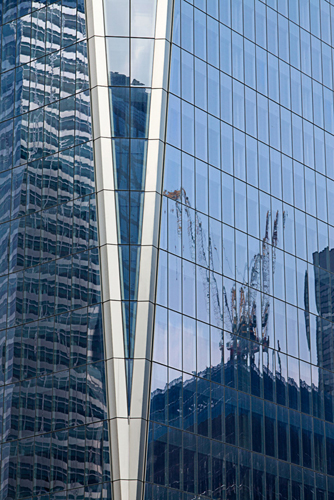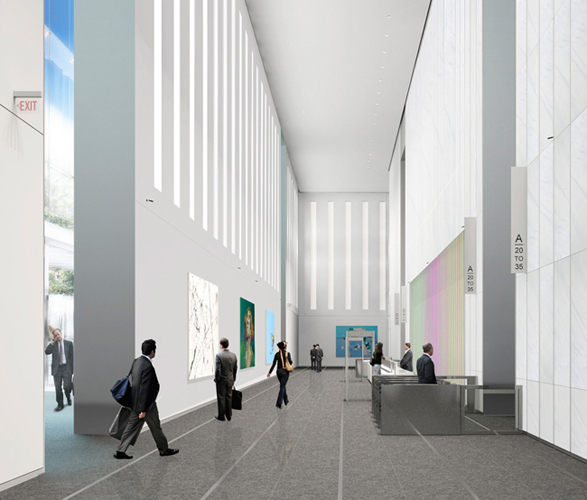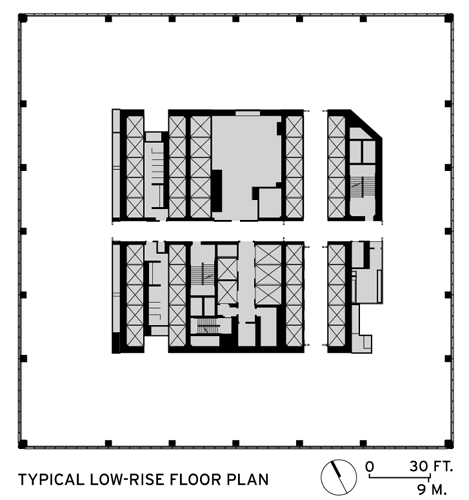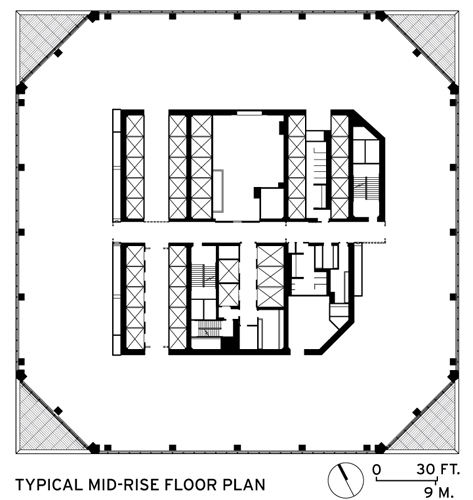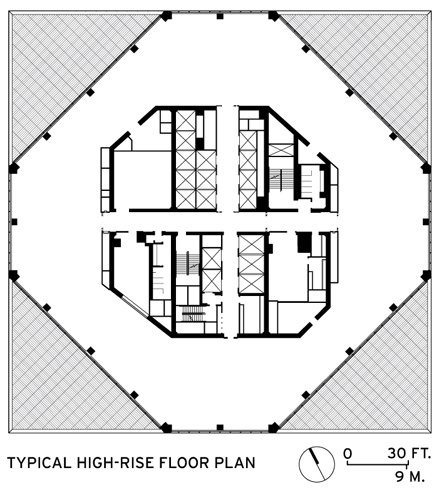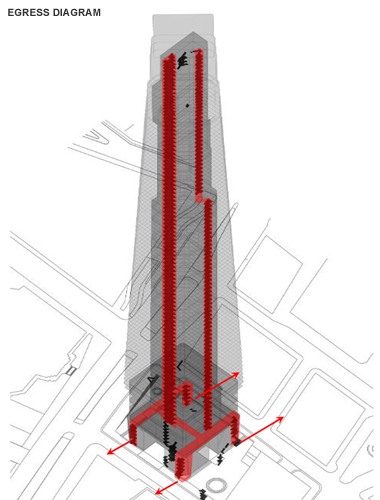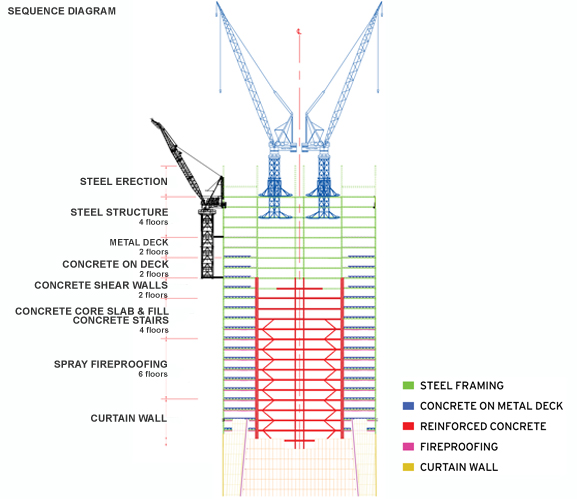One World Trade Center
A controversial tower rises at ground zero


























Architects & Firms
New York, New York
There is no denying that One World Trade Center (WTC), the 104-story tower now rising at the northern end of the Ground Zero site, is a tremendously ambitious commercial real estate venture. The building, owned by the Port Authority of New York and New Jersey with the developer Durst Organization holding a 10 percent stake, will contain 3.1 million square feet of office space when completed in late 2013. Below grade, connected to the WTC site’s vast underground transportation infrastructure, there will be 55,000 square feet of retail, and near the top, the tower will include a two-level observation deck and a restaurant. But when the designers of the $3.19 billion project describe the building, they generally focus first on its potential as a symbol: “It will serve as the marker of the 9/11 memorial on the skyline,” says David Childs, consulting design partner to Skidmore, Owings & Merrill (SOM).
This hybrid of a civic emblem and a speculative office building, which now has framing approaching the 80th floor, will have a stainless steel capped glass parapet whose edges mark 1,362 feet and 1,368 feet. The elevations are the heights of the original Yamasaki & Associates–designed Twin Towers completed in 1972. With the help of a spire that extends 408 feet above the parapet, One WTC will reach 1,776 feet — a height set in Studio Daniel Libeskind’s 2002 Ground Zero master plan, making it the tallest building in the Western Hemisphere.
The building should be immediately identifiable, and not only because of its height: The scheme has a simple, iconic form, much like that of the Washington Monument, says Childs. It includes an 84-story shaft rising from a base that, in plan, measures 187 feet tall and 200 feet wide. Above this almost cubic pedestal, which contains mechanical floors stacked on top of a 50-foot-tall lobby, One WTC’s corners are chamfered back, creating progressively smaller floor plates that gradually shift from a square above the podium to an octagon at midsection. At the top, it is once again square, but 150 feet on a side and rotated 45 degrees from the base.
Although the “twisting” of the floor plates produces a tapering tower with a complex geometry, it is a geometry that is much more straightforward than that of an earlier version designed by SOM in collaboration with Libeskind. Then referred to with the emotionally charged name the “Freedom Tower,” the building had a torqued cable-net exterior and an off-center spire intended to evoke the torch of the Statue of Liberty. This proposal was scuttled in 2005 and the site shifted, after New York City police objected to its proximity to the busy roadway at the western edge of Ground Zero. Both the abandoned scheme and the tower under construction were commissioned by developer Larry Silverstein, who ceded control of the project to the Port Authority in April 2006 (see time line).
Despite One WTC’s adjusted location, some still regard it as an obvious terrorist target. However, its designers point out that it will have enhanced security and life-safety systems, including a robust, reinforced concrete shear-wall core surrounded by a steel moment frame spanning 45 feet to perimeter columns. The building is part of a post–September 11 trend for New York City office towers to move away from all-steel structures toward composite systems. And although concrete shear-wall construction is just one way to design and harden a core, in the case of One WTC, the approach was deemed the most appropriate due to the tower’s height and slenderness, according to Ahmad Rahimian, CEO of WSP Cantor Seinuk, the project’s structural engineer. “For tall and supertall buildings, a reinforced concrete core provides excellent resistance to wind, earthquake, and gravitational loads by virtue of its mass, strength, stiffness, and fire-protection properties,” he says.
If the tower, with its composite structure, were under construction in another locale, pouring of the concrete core would likely have advanced ahead of the surrounding moment frame’s erection. But the sequence at One WTC is reversed, with steel work leading core construction by about 10 stories on any given day due to “union jurisdictional issues” peculiar to New York City, says Mel Ruffini, executive vice president at Tishman Construction. The company, part of AECOM, is the project’s construction manager.
Pouring of the slabs on the floors’ metal deck lags about eight levels behind the top of steel erection, with other trades following core forming, including application of cementitious fireproofing and curtain-wall installation.
When designing the structure, engineers took this sequence into account, incorporating a steel ring beam into the core. Although the surrounding steel superstructure ties into this beam, its primary purpose is to serve as anchorage for erection steel and for the self-climbing concrete formwork that contractors “jump” within the core void using hydraulic jacks. “We needed to consider both temporary and permanent conditions,” says Rahimian.
Surrounding the moment frame, cladding operations are well under way, with installation of the curtain wall’s low-iron insulated glazing units (IGUs) already extending from the top of the cubic podium past the 50th floor. The IGUs are 5 feet wide and 13 feet 4 inches tall — the largest production IGUs available. They have thicker than typical outer lites (3⁄8-inch thick versus the more standard 1⁄4 inches) and laminated inner lites whose thickness varies depending on location (some are thicker than others due to security concerns). Although the IGUs are heavier than standard units, which complicates installation, the panels’ size allows them to span the full floor-to-floor height without intermediate mullions or spandrels. The thickness of the outer lites, along with inner lites’ lamination, should also prevent “oil canning,” or pillowing of the glass panels, says SOM managing director Kenneth Lewis. The goal is to create a “uniform and crystalline” surface — or one that appears to be “shaved and carved,” adds Childs, again alluding to the form of the Washington Monument.
At the ground, each side of the building will have a cable-net-supported glazed portal, 60 feet tall, although the lobby will be otherwise surrounded in concrete. The architects had planned to camouflage the podium with tempered and laminated prismatic glass panels that would reflect, refract, and transmit light, in order to “establish a relationship with the water cascading in the memorial pools,” says Childs. However, after discovering that tempering caused the panels to bow, interfering with the laminating process, the project team devised another solution. The alternate, which sources describe as glass fins projecting from the facade at various angles, is now in the bidding phase but has yet to be finalized.
Many of the life-safety strategies being implemented at One WTC were pioneered at 7 WTC — the 52-story office building that sits just beyond the edge of the Ground Zero site, catercorner to One WTC. Completed in 2006, by an almost identical design and construction team — including SOM, WSP Cantor Seinuk, and Tishman — it has features that exceed the requirements of the New York City Building Code, which are also included in the newer tower. For example, air intakes are located well above grade, which make it difficult to introduce biological or chemical contaminants into the ventilation system. Both towers also have widened egress stairwells for emergency evacuation with doors positioned so that anyone entering easily merges with the flow of exiting people. In addition, the stair landings have designated “areas of refuge” where occupants who are unable to descend on their own can wait for assistance.
The tower’s life-safety features new to New York City skyscraper design include a stair for use only by first responders and a “fireman’s lift” — an elevator used as a service elevator during the building’s day-to-day operations but equipped with water-resistant controls and a second door that opens onto a pressurized, dedicated fireman’s lobby. The other service elevators have water-resistant controls as well, and are contained within a smoke-resistant enclosure, allowing first responders to press them into service if needed.
Tenants have begun to make commitments for space in the building. In May, the Port Authority finalized a deal with magazine publisher Condé Nast for one million square feet on 21 floors. (Last year, the Chinese real estate company Vantone signed a lease for 200,000 square feet on floors 64 though 69.) It’s not clear whether the appeal is in the attractive lease terms, the advanced security features, or the finally visible iconic geometry of the structure. Whatever the lure, New York’s tallest skyscraper is beginning to fill up, a sign of upturn for downtown.
Tower's Topper Designed with Potential Tenants in Mind
|
One WTC is topped by an antenna that extends 408 feet above the building's parapet, providing space for broadcast industry equipment. It has a cable-stayed steel mast protected by a radio-frequency 'transparent' cylindrical enclosure, with a communications ring for additional equipment, lighting, and window-washing rigs at its base. Rendering: Courtesy SOM |
A spire extending 408 feet above the roof parapet of the 104-story One WTC will make the building 1,776 feet tall — an elevation set in the Ground Zero master plan. For the building’s architects, the element is more than a tactic for helping the tower achieve a symbolic height. “It is critical to the nature of the design,” says David Childs, SOM consulting design partner. He explains that it visually completes the tower, much the same way a capital completes a column.
For One WTC’s developers, the piece serves another purpose: It is a potential revenue source, providing leasable space for broadcast equipment. And although there are not yet tenants for this real estate, the spire has been designed to meet broadcast industry criteria, including tight limits on lateral movement. Near its tip, the underlying armature is engineered to deflect only 0.5 degrees in a sustained 50-mile-per-hour wind, according to Christian Rieser, an associate with Schlaich Bergermann, the structural consultant for the antenna.
Rieser’s firm devised a 411-foot-4-inch-tall mast with a base and seven stacked sections that gradually decrease in diameter (an eighth section contains an illuminated beacon whose enclosure marks a point 441 feet 4 inches above the roof slab and the 1,776-foot elevation). The mast sections, which range from 40 feet to just over 100 feet long, have different shapes and rely on different fabrication methods. For example, some sections will have 20 sides, others only four. Some will be made of steel plate with cutout zones so that equipment can be inserted, while others will have latticelike construction, affording equipment attachment points. Cast-steel connectors will allow for transition between adjacent sections with differing geometries.
 Diagram: Courtesy Schlaich Bergermann |
Cables of aramid, a synthetic fiber selected because it does not obstruct broadcast signals, will anchor the antenna under a 65-foot-tall, 125-foot-diameter lattice ring at the mast’s base. The ring will support additional equipment, lighting, and window-washing rigs.
As with the cable stays, a radio-frequency “transparent” material was required for the protective shroud, or radome, covering the mast and sheltering maintenance platforms. The tapering enclosure, 30 feet in diameter at its widest point, will have inherent stiffness due to its folded-plate assembly of 2.5-inch-thick fiberglass-and-foam sandwich panels. Finlike “strakes” will protrude from the radome. These were added after wind tunnel testing revealed the need to mitigate vortex shedding — a phenomenon that creates wind eddies on two sides of a cylinder, inducing side-to-side movement that could cause structural fatigue. But if the architects’ rendering resembles reality, the strakes also enhance the radome’s sculptural qualities as they spiral from its base to the glowing beacon.
|
Diagram © SOM |
People
Architect: Owner/Developer/Ground Lessor: 1World Trade Center LLC (a wholly owned corporation by the Port Authority of New York and New Jersey)
Christopher Ward, Executive Director
Development Advisor
Original Developer
David Childs, FAIA, Consulting Design Partner
SOM Team
Engineer(s):
Consultant(s):
General contractor:
Photographer:
Renderer(s): CAD system, project management, or other software used: Revit, AutoCAD, Autodesk Constructware; Rhino; 3D-Max. Gross square footage: 3,500,000 square feet Total construction cost: $3.19 billion Completion date: 3RD QT 2013 |
Products
Structural system
Exterior cladding
Glazing
Interior finishes
Lighting
Conveyance
Security |




